« das kleine, Intiem »
(Tuned City, Berlin _v)
(( --> [ _o ] [ _one. ] [ _two. ] [ _three. ] [ _four. ] [ _five. ] [ _six. ] || [ found ] ))
december 23, 2008.
Maybe it was not such a good idea after all. Or what I actually mean: it was a great idea, unless that idea was to have Tuned Citizens hop over to the Weserstraße for a das kleine before-afterparty.
Some, or maybe even all, members of the Phonographic Arkestra peeped in, though. That was some time early in the day. But then these were Wolfgang's students, and one of the things they had to do, one of their assignments, as part of their visit to Berlin ( * ), was: "you will go and see an archive". So Wolfgang had told them to get over to Cake & Coffee's, and see the Found Tapes Archive.
Now I do think this idea to be particularly brilliant. You see it here in the picture. That tells it all ...
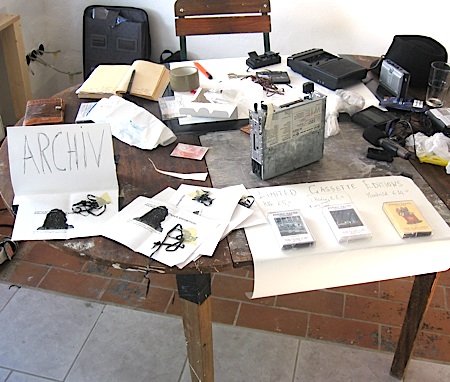 |
The sympathetic austrians soon went on for the Funkhaus in the Nalepastraße, though, which was home to this final Tuned City day. The Funkhaus is not in Mitte. It is further down from Neukölln, in the south-east, in Oberschöneweide. When I was in Berlin early 2007, Rinus was still living down in Schöneweide, and we past the Funkhaus every day on bike. It was built between 1951 and 1956. Now a historically protected building, until 1990 it was home to the former East German radio.
Of course Arkestra members and other Tuned Citizens spent this once more beautiful Berlin day out there, where Tuned City offered a unique chance to learn about the Funkhaus and its history first hand from Gerhard Steinke, who has been working there as a sound-engineer for over forty years. Steinke was in charge of the curiously named 'Laboratory for Acoustic Musical Obstacles' (somewhat less curious in German: Labor für Akustisch-Musikalische Grenzprobleme), where also the long time forgotten and only rather recently 're-discovered' Subharchord was developed. This electronic instrument apparently at the time was the East German answer to the western Mixtur-Trautonium, also based upon the mixing of sub-harmonics and probably best known for its use in the creation of the sound track to Hitchcock's 'The Birds'. Unlike the 'natural' harmonics (overtones) which are multiples of the frequency of a fundamental tone, subharmonics (undertones) are fractions of the fundamental tone. Subharmonics - as far as I know - do not occur 'in nature' ...
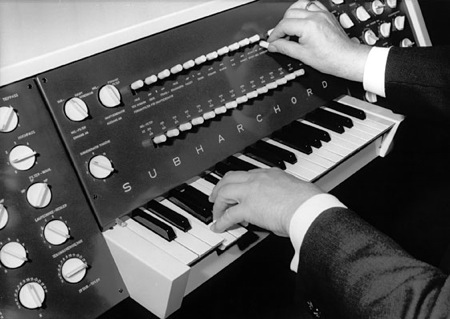 |
The interview with Steinke and acoustician Gisela Herzog, who developed the room acoustics of many large buildings in the former German Democratic Republic is one of the informative highlights in the Tuned City Reader, and I am sorry to have missed Steinke's guided tour of the building, as well as the several site specific performances that were part of saturday's Tuned City program.
No. Saturday's « das kleine, Intiem » in Neukölln did not manage to draw any Tuned Citizens. At all. Cake & Coffee proved to be no match for the Funkhaus. Which of course does not mean that it was a waste of time to be there. For that it wasn't.
For one was it a great pleasure that I finally got to meet Ben Roberts, an englishman living in Madrid. I have known Ben and his 'Our Magnetic Lifetime' online for ages, but we never met in real life, until that saturday at Cake & Coffee's, on the occasion of « das kleine, Intiem ». Ben actually flew in especially from Spain to present his Sounds of the Flohmarkt, and did so in a fizzy and animated choreography for a man and his found tape machines. Ben knew his tapes and their voices, and pretty well managed to make them converse ...
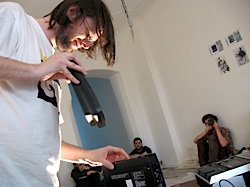 You may listen to extracts from a fieldrecording made by Ben Roberts at
the Bergmannstraße flea market on sunday morning july 6th, as well as to
a substantial part of Ben's presentation of footage found at Berlin flea markets
on earlier occasions - telephone answering messages
and seminar talks - in "Hier ist deine Mutter ...", which is the
title I gave to the fourth in the ongoing series of radio-dicta-phonic sound
reports that together form the 14th edition of Raudio, audio-documenting my early summer stay at Neukölln, Tuned
City and das kleine.
You may listen to extracts from a fieldrecording made by Ben Roberts at
the Bergmannstraße flea market on sunday morning july 6th, as well as to
a substantial part of Ben's presentation of footage found at Berlin flea markets
on earlier occasions - telephone answering messages
and seminar talks - in "Hier ist deine Mutter ...", which is the
title I gave to the fourth in the ongoing series of radio-dicta-phonic sound
reports that together form the 14th edition of Raudio, audio-documenting my early summer stay at Neukölln, Tuned
City and das kleine.
I had hoped that Ben would bring his hand magneto-readers: tape playback heads that you can pass along magnetic tape or other magnetized materials (like metro tickets and credit cards) by hand, and thus play (as in Nam June Paik's Random Access Music). He had done so the other time he came to Berlin, during the august 2007 edition of das kleine, when he put up hand-readable magnetics along the walls of Udo Noll's place (as you may read, see and hear in Nick Currie's iMomus blog report from way back then).
But I'm afraid that here hoping was not enough ... I should have asked him to, because I would have loved to try and play the sleazebag quote, written in tape. We'll have to keep that for some next time, though ...
Apart from Ben Roberts also two musicians/sound artists from Basque Country came over to Neukölln to animate « das kleine, Intiem ». Xavier Erkizia and Oier Iruretogoiena had also performed on friday, during das kleine's Big - Tuned City - concert (about which I will tell you more in the upcoming final episode of this Tuned City report). There they were responsible for the best moment of the evening, the one that managed to actually surprise me (and others): Xavier and Oier suddenly retracted their sounds, away from the big 4-channel PA system, and continued their play through a small amplifier standing on their table. It was a simple, but dramatically effective gesture, that momentarily restored the intimacy that listening to these das kleine field recording performances demands, if it is not to be mere ambient sound tapestries, akin to muzak, or the 'real life sounds from cities and natures' mixes that here and there indeed are offered as atmospheres in the chill-out rooms of metropolitan dance feasts ...
Soinu
Mapa sounds ( ** ) played back from Oier´s laptop
and wrapped a thin schizophonic Basque Country blanket around us and the
tasty bite of Neuköllner space & time that we occupied. It mixed
with the sounds of Berlin bikes, mopeds, cars and neighbors passing, with
our voice and the clinking of our glasses, the ringing of our cell phones
and the squeaking of our shoes, with the sounds of turkish kids playing,
with that of local birds singing, of cats meowing and dogs barking. At times
it was not easy to tell which sounds came from where.
(I almost wrote: "Which sounds
were real" ... but of course any sound is a 'real sound'.
The only sounds that are not real are the ones that you imagine ...)
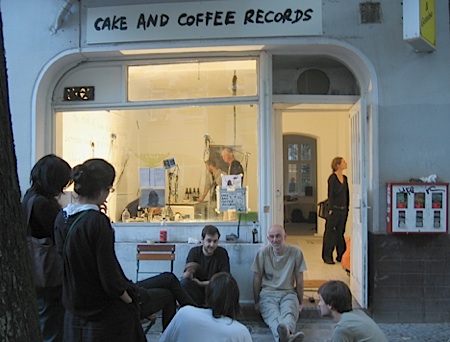 |
In the picture you see how we sat outside talking, on the pavement in front of Cake & Coffee´s, while slowly the sun set. And with the falling of the evening the stories came. A whole lot of stories. Many of these were about art, several about art's relation to politics and related institutions that do or do not support it; or not in the 'right' way. Some were about struggling independent artists facing hardship, and with little or no audience to support their just and noble cause.
See how we look like a troupe of cowboys and indians that buried the hatchet already long time ago but who ever since have continued to smoke the peace pipe, simply for the taste of it? Maybe you will be able to imagine the stories (many of them I have forgotten). Do imagine the sounds ... Imagine us sitting out there, sometimes speaking, always listening, sometimes nodding ...
Some of the stories found their
way onto my dictaphone, and from there on to Raudio #14. In "Hier ist deine Mutter" you will hear for example how
Rinus told us
about some of his spanish adventures and the idea to have the Bilbao
Musica Ex Machina festival curate a series of
toilet music compositions for the Bilbao
Guggenheim Museum. ![]() Rinus said he was convinced that a main reason for this interesting proposal not being accepted by the museum is that, actually,
the Bilbao Guggenheim is ashamed of its own toilets, and would rather not let them get more attention than strictly necessary. When he
went there, to check out the toilets, it took him some twenty minutes to find them, he told us. "They are so far away, that you
can't find them. They put them behind the locker room where the cleaning lady puts her things ... They were like hardly three square
meters and dirty ..." And so Rinus at least understood why the Guggenheim was not that eager to have especially composed toilet
music playing in its restrooms.
Rinus said he was convinced that a main reason for this interesting proposal not being accepted by the museum is that, actually,
the Bilbao Guggenheim is ashamed of its own toilets, and would rather not let them get more attention than strictly necessary. When he
went there, to check out the toilets, it took him some twenty minutes to find them, he told us. "They are so far away, that you
can't find them. They put them behind the locker room where the cleaning lady puts her things ... They were like hardly three square
meters and dirty ..." And so Rinus at least understood why the Guggenheim was not that eager to have especially composed toilet
music playing in its restrooms.
"Maybe someone should classify the world's major museums according to their
toilet spaces," I suggested.
"More than that: I think that one can only really understand a
culture when one has studied its toilets," Rinus replied.
He might be right, and ever since I have become more attentive to the architecture and design of - especially - our museum's toilets. Unlike Rinus in Bilbao though, I do not have any bad experiences to report on yet. On the contrary. When for example late august I spent some time inside the restrooms on the third floor of the Musée des Beaux Arts in Lyon, I was pleasantly struck by their overall appearance. They were spacious, private and had a certain style. In view of our Neuköllner discussion it made me wonder whether maybe this was due to the fact that the most contemporary art in the collection of this Lyon museum was from the very early 1960's ? Even more surprising: in the quiet of these WC's there sounded what I thought had to be an especially composed sonic environment. There was a distinctive, though not intrusive, undulating sound filling the cubic space, reflected by the surfaces decorated in aluminum and ceramic. It was like granular singing, with lots of interesting, deep harmonics. (Come to think of it, it did sound a bit like the sounds produced by a subharchord ...:) It was only when I began to record some of it onto my dictaphone, that I found that I was mistaken. Not that this does make the resulting soundscape less interesting, but what I heard was not a custom piece of composed toilet music. The sounds were in fact produced by the toilet's air refreshment system.
...
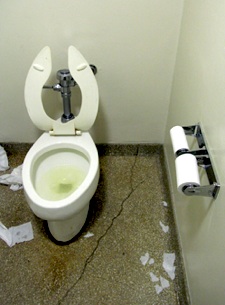 Neither
the Bilbao Guggenheim nor the Lyon Musée des Beaux Arts at the time of this
writing are featured on the Toilets
of Art website, which, founded in 2005, indeed is a collection of photographs
of art museum toilets. Remarkably, the collection seems to fully confirm Rinus'
observation on the shittyness of Guggenheim loos through its picture of
a toilet at the New York Guggenheim.
You can see it here. It is by and far the less inviting 'là où le roi se rend seul' in the series of online
museum toilet photographs. Though when interviewed for a recent New
York Times post, Rusel Parish, the New York artist who took most of
the pictures and who curates the collection, comments on the apparent fact
that the NY Guggenheim's "is not the
cleanest of all of the bathrooms" by pointing that it "is an older museum",
Rinus's experience in Bilbao hints at that this might, au contraire,
be a structural problem, and a matter of Guggenheim policy ...
Neither
the Bilbao Guggenheim nor the Lyon Musée des Beaux Arts at the time of this
writing are featured on the Toilets
of Art website, which, founded in 2005, indeed is a collection of photographs
of art museum toilets. Remarkably, the collection seems to fully confirm Rinus'
observation on the shittyness of Guggenheim loos through its picture of
a toilet at the New York Guggenheim.
You can see it here. It is by and far the less inviting 'là où le roi se rend seul' in the series of online
museum toilet photographs. Though when interviewed for a recent New
York Times post, Rusel Parish, the New York artist who took most of
the pictures and who curates the collection, comments on the apparent fact
that the NY Guggenheim's "is not the
cleanest of all of the bathrooms" by pointing that it "is an older museum",
Rinus's experience in Bilbao hints at that this might, au contraire,
be a structural problem, and a matter of Guggenheim policy ...
...
Thus passed « das kleine, Intiem », which came to a stop only when suddenly the spotlight that was illuminating my found tapes sleazebag wall exploded with a big snappy bang ... It was a wonderful evening, and it is difficult to imagine das kleine in Berlin ever again getting more intimate than it was that early july saturday evening on Cake & Coffee's pavement in Neukölln.
We should have had a campfire.
next: mok mok jaha für das kleine in Berlin
notes __ ::
(*) It was actually one of the conditions the
students had to fulfil in order to get their travel expenses paid by their institution. [ ^ ]
(**) Soinu
Mapa is a collaborative online sound map, aimed at the presentation
and sharing of field recordings of the soundscapes of the Basque Country.
It's starting point are a series of recordings made in 2001 by the mexican
artist Luz Maria Sanchez during his stay as artist in residence at the Arteleku
contemporary art center. [ ^ ]
tags: Berlin, Neukölln, foundtaping, found tapes, das kleine, museum toilets, subharchord, trautonium
# .287.
comments for « das kleine, Intiem » ::
|
Comments are disabled |
Read about Berlin on the SoundBlog:
(august 4, 2022) - Berlin: Zero Cohesion (3)
(july 24, 2022) - Berlin: Zero Cohesion (2 = ©)
(july 11, 2022) - Berlin: Zero Cohesion (1)
(november 11, 2021) - A Berlin Reader
(august 05, 2011) - (I can't get no) Immediate Satisfaction (Diktat in Berlin_iii)
(july 31, 2011) - 'Kommt raussi!' (Diktat in Berlin_ii)
(july 29, 2011) - 'Where ist Ausland?' (Diktat in Berlin_i)
(february 07, 2009) - « Mok mok jaha für das kleine in Berlin (Tuned City, Berlin_vi)
(december 23, 2008) - « das kleine, Intiem » (Tuned City, Berlin_v)
(december 08, 2008) - un-Tuned City (foundtaping in Neukölln) (Tuned City, Berlin_iv)
(november 12, 2008) - Neurosen der Präzision (Tuned City, Berlin_iii)
(november 07, 2008) - Cake & Coffee (Tuned City, Berlin_ii)
(october 29, 2008) - Light budget, heavy thinking (Tuned City, Berlin_i)
(october 12, 2008) - Hanna's Sirens (Tuned City, Berlin_o)
(july 01, 2007) - dinges (Back to Berlin, iii_3)
(april 25, 2007) - Fluxissage
(april 12, 2007) - reek or (Back to Berlin, iii_2)
(april 08, 2007) - i feelt (Back to Berlin, iii_1)
(march 07, 2007) - found tapes (Back to Berlin, ii)
(february 27, 2007) - "Bo tuny te..." (Back to Berlin, i)